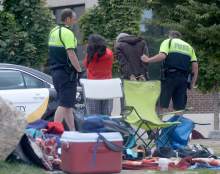This is an archived article that was published on sltrib.com in 2016, and information in the article may be outdated. It is provided only for personal research purposes and may not be reprinted.
Dealing with the homeless crisis in Salt Lake City — and everyone agrees that it is a crisis — has been difficult because there are a lot of answers to the problem, none of them easy, none of them cheap.
Friday, a wide-ranging plan to attack the problem on multiple fronts came together. There are still details to be worked out and choke points where it could all fall apart. But just the fact that various centers of power — the mayors of the city and the county, the City Council, even the speaker of the Utah House — have reached a general agreement on how to proceed is good news indeed.
There has been no shortage of ideas, nearly all of them unpopular with someone. They move too quickly to be studied and absorbed or too slowly to face the crisis at hand. They rely too much on the nonprofit sector or too much on taxpayers. They are too centralized or too decentralized. They are too bricks-and-mortar or too social worker. They are too harsh on people in need or too soft on people who have been making a lot of bad decisions, even committing criminal acts. They unfairly focus on places where the homeless already congregate or aggressively seek to spread facilities to other parts of town or other communities where they may not be welcome.
In recent months — as the growing numbers of homeless people in the Rio Grande-Pioneer Park neighborhood clashed with efforts to add new commercial and residential developments to the same area — city, county and state officials have formed committees, hatched ideas, allocated money and proposed grand solutions. With little in the way of lives improved or even decisions made.
Friday, after rounds of shuttle diplomacy that held up a planned City Hall news conference by some two hours, entourages associated with City Mayor Jackie Biskupski, the City Council, County Mayor Ben McAdams and House Speaker Greg Hughes hammered out the deal.
Details include the agreement that a county plan to use state money to build two new 250-bed shelters for the homeless in the city will become a plan for four facilities of no more than 150 beds each. That will cost more, to build and to operate, but is based on the idea that such operations will not only better serve those in need but also be easier to find locations for, as they will be less daunting to the neighborhoods that will house them.
Everybody is willing to put up more money, hold more public hearings and create new approaches. Everyone says they see the need for ongoing operating budgets, case management, treatment for the mentally ill and for those weighed down by substance abuse. Simply moving or replicating the overwhelmed shelters for the homeless that already exist is not a plan that makes anyone happy.
The plan also recognizes that, for reasons that involve more than helping the homeless, the available stock of truly affordable housing all along the Wasatch Front, and throughout the state needs to be vastly expanded. That could involve means that include public financing or impact fees on other, not-so-affordable developments.
Programs that place housing within reach of low-income households have the potential to be rolled out much more quickly than the creation of new shelters and other facilities, and should be pursued.
The great hope that comes from Friday's announcement is that the various levels of government that have responsibility for making our community livable, for the most vulnerable and for the rest of us, are ready to face the problem together.
Which is the only way any of them have a chance.



